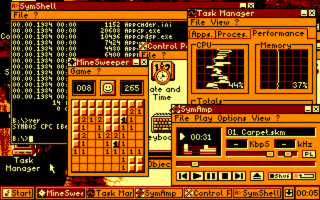Introduction
Already in the 80's, only few years after the release of the Commodore C64, the legendary GEOS by Berkeley Softworks appeared and set the standard for a windows-based operating system on c64. It was a graphical user-interface (GUI) which was similar to the old desktop of the Apple Macintosh. Powerfull applications were made available for GEOS like GeoWrite (similar to MS-Word) or GeoCalc (similar to MS-Excel). It was incredible, that an 8bit-machine with only 64K was able to realize such an operating system!
On the Amstrad CPC many efforts to build a decent GUI were made as well. In most cases they were just extensions to realize a WIMP (Windows, Icons, Menus and Pointers) environment but weren't true operating systems with their own kernel, memory-management and so on. The CEUS Desktop 2.0 (1990) by Prodatron was just such an extension-system.
Therefore, the CPC's own OS (in combination with AmsDOS) and CP/M were the only two known OSes for the series, but the question remained: since most CPCs have 128K (most C64 only have 64K), a screen-resolution of 320x200 with 4 colours (C64 only has 2 colours for each 8x8 area in 320x200) and some more advantages, why not have something similar? So the SymbOS-Project was born. SymbOS stands for "SYmbiosis Multitasking Based Operating System". SymbOS is a demonstration of what has been achieved on the CPC: real preemptive multitasking, dynamic memory-management for up to 576K and a totaly MS-Windows-like GUI are the three most important features.
SymbOS started being developed by Prodatron in November 2000.
History
The following is a list of important events during the SymbOS development.
- 11/2000: Development started
- 06/2001: First preview of the desktop on the Klassentreffen 2001 party
- 07/2001: First screen shots in the internet, causing several rumours about a possible hoax
- 06/2002: Second preview of the desktop on the Klassentreffen 2002 party
- 09/2004: SymbOS development has been continued after a break of three years
- 12/2004: Full CPC IDE support implemented; preview of a harddisc based movie player, which used the SymbOS IDE/FAT routines
- 01/2005: Release of the first official preview on the Welcome 2005 party
- 09/2005: SymbOS development has been continued again
- 12/2005: Full SYMBiFACE II support implemented
- 01/2006: SymbOS is part of the CPC TREX startup system now
- 04/2006: SymbOS release 1.0 is out
- 05/2006: Development of the MSX version started
Features
- Micro kernel
- Maximum amount of supported RAM: 576 KB
- Maximum number of processes: 32
- Number of different process priorities: 9
- Maximum number of timers: 32
- Maximum number of open messages: 64
- System manager
- Maximum number of applications: 16
- Maximum application core size: 63 KB
- Desktop manager
- Maximum number of windows: 32
- Maximum number of controls per window: 1000
- Maximum possible screen resolution: 16.000 x 16.000 pixel
- File manager
- Maximum hard disc size: 128 GB
- Maximum file size: 2 GB
- Maximum number of devices: 8
- Maximum number of open files: 8
- Source code
- Source code size (OS Release 1): ~ 30.000 lines
- Source code size (Applications): ~ 34.000 lines
- Total size of the Z80 source code: ~ 64.000 lines
Applications
- Applications
- SymCommander (file and disc management)
- SymPlay (video player)
- SymSee (picture viewer)
- SymAmp (jukebox music player)
- Tools and games
- SymSnap (emulator snapshot loader)
- DiskDeDumper (image to disc transfer)
- Speech (voice synthesizer)
- Pocket Calculator (calculator)
- SYMBiFACE II rom manager (rom management for the SYMBiFACE II)
- CPC TREX starter (rom and disc image configuration for the CPC TREX)
- MineSweeper (game)
- System programs
- Control Panel (system configuration)
- Task Manager (system monitor)
- SymShell (command line interface)
